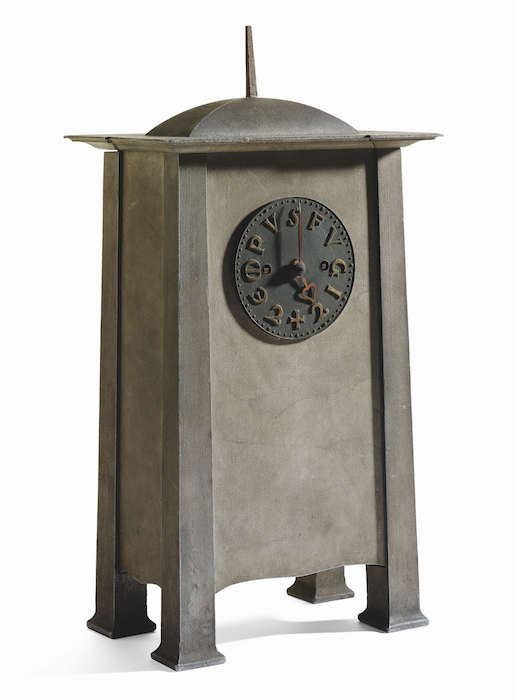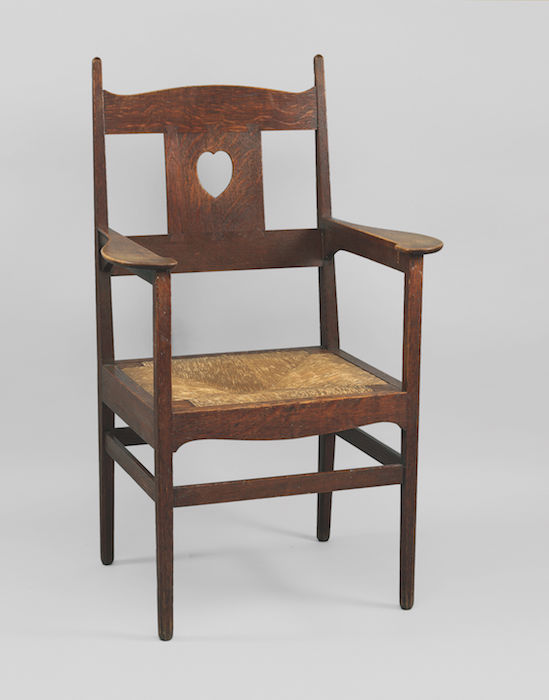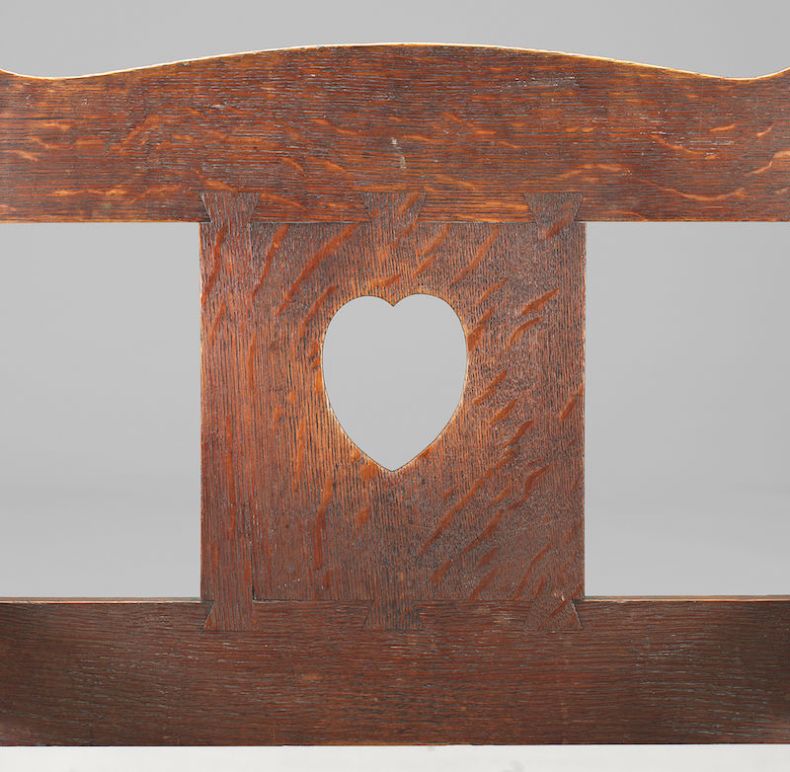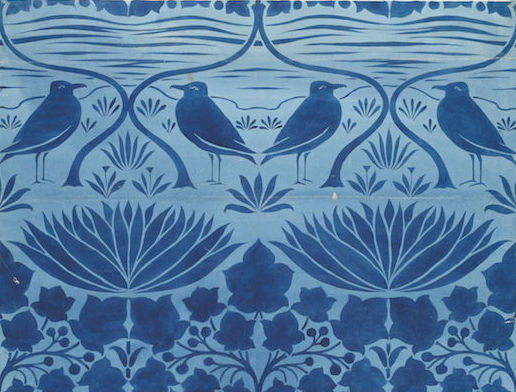C.F.A. Voysey (1857–1941) was one of the most important architect-designers of the late 19th and early 20th century. The son of Rev. Charles Voysey, a reforming minister and founder of the Theistic Church, Voysey regarded good design as much a moral crusade as a practical mission. It was a sine qua non that he knew better than most of his clients, even to the point of stipulating the precise positioning of pieces of furniture, such as the dining room table, in houses that he was designing. Not surprisingly he was his own best client: The Orchard, Chorleywood, the house he designed in 1899 for his wife and family – ‘the purest expression of a modern country cottage, and the only home he claimed he wanted to live in’ – became a show piece for his design theories. In the fine monograph, C.F.A. Voysey, published 20 years ago by Phaidon, Wendy Hitchmough touched upon Voysey’s design only in as far as it affected his architecture. The three authors of C.F.A. Voysey: Arts & Crafts Designer instead approach him from the opposite angle, concentrating entirely on his design work – flat and three-dimensional – referencing it to his architecture only when relevant. Taken together, the two works offer a comprehensive picture of the overall practice of this obsessive, impossible, brilliant man.
All three authors are curators at the Victoria and Albert Museum and for this superbly illustrated book they draw extensively on the V&A’s holdings, as well as on the large Voysey collection at the Crab Tree Farm in Illinois. Karen Livingstone, the lead author, has contributed the introduction, as well as an informative essay on Voysey’s metalwork and ceramics; Linda Parry has written on his flat pattern designs for wallpaper and textiles, and Max Donnelly on his furniture. In every branch of his activities Voysey emerges not just as the ‘son of a preacher man’, but as a preacher himself – one intent on spreading the gospel of good design, as seen through his own eyes. He made a point of commissioning first-rate photography of his houses and the artefacts he designed for them, and had these disseminated widely so that his work was known not only in the UK but also on the Continent and in the US. Most self-publicists promote their wares for financial gain, but not the puritanical Voysey who held it immoral to make large profits. He even, on occasion, eschewed payment, believing that if both he and the manufacturer were paid the cost would be too high. Not surprisingly given such an attitude, and the change of fashions, he suffered a severely impoverished old age.

Clock (1903), designed by C.F.A. Voysey and made by W.H. Tingey. Victoria and Albert Museum, London
Apart from the doctrine of moral responsibility that had been impressed upon him from birth, Voysey’s background and training was that of Pugin and the Gothic Revival. He entered the office of John Pollard Seddon at the age of 16, where he spent five years before joining George Devey’s practice. Devey, a member of Rev. Voysey’s Theistic Church, was at the forefront of the modern cottage movement and, as such, had a considerable influence on Voysey’s architectural practice. But, as Livingstone points out, it was his time in Seddon’s chambers that ‘provided him with both sound and practical training’, and which led him to regard everything inside the house as being within the architect’s province – from ‘fittings and furniture to the very toothbrushes’. Given his obsessive nature and his desire to control, this suited Voysey perfectly. He had a phobia about dust and dirt, always wore collarless jackets and, in a note to one contractor, instructed him to provide an on-site office which would be equipped at all times with a ‘stool, drawing board, basin, soap, towel and clothes brush’. Given that clutter and cleanliness are antipathetic, simplicity – ‘my puritanical love of simplicity’ as Voysey put it – became the touchstone to his designs, along with a love of natural forms. An anonymous writer in the Studio in 1897 commented that ‘the value of Mr Voysey’s art is not in the use of any material, or on any mannerism, but in his evident effort to seek first the utilitarian qualities of strength and fitness, and to obtain beauty by common honesty.’

Armchair (c. 1902), designed by C.F.A. Voysey (1857–1941) and probably made by F.C. Nielson. Crab Tree Farm, Illinois
In connection with the furnishing of his own buildings, Voysey worked closely with Arts & Crafts cabinetmakers, especially F.C. Nielsen and Arthur Simpson, and with metal workers such as W. Bainbridge Reynolds and Thomas Elsley. In other respects he veered away from this tradition, instead pioneering a new art/craft trade – that of the independent designer – which was not to come into its own until well into the 20th century. As an independent one-man studio, Voysey produced and sold countless designs, particularly for textiles, carpets, and wallpapers. He had no further involvement or control over how his designs were manufactured – be that in terms of what colours were used or the quality of materials. With the wide dissemination of his designs, Voysey’s favourite motifs – small birds and hearts – became the ubiquitous symbols of the democratisation of the Arts & Crafts movement. Voysey-esque design became the hallmark of every leafy suburb in every town and city throughout Britain during the interwar years; speculative builders replicated his hipped roofs, white woodwork, glazed tiles, stained glass door-panels and decorative metalwork, taking to its logical conclusion what one late 19th-century commentator referred to as his ‘simple, cosy utilitarianism’.

Detail of C.F.A. Voysey’s (c. 1902) armchair
Voysey’s designs were easy to parody, but what these suburban builders failed to achieve was the refinement of the originals. As Donnelly says, Voysey relied on the control of surface and silhouette to manipulate space, and this could only be achieved ‘through subtle nuances in outline and proportion’. These qualities are demonstrated in the present volume by the outstanding specially commissioned photography, designed not just to illustrate the object but, where desirable, to reveal the method of construction, as in the detailed plates showing the wooden pins and jointing of Voysey’s most typical armchair.
C.F.A. Voysey: Arts & Crafts Designer, by Karen Livingstone, Max Donnelly, and Linda Parry, is published by V&A Publishing.
From the July/August issue of Apollo: preview and subscribe here
Unlimited access from just $16 every 3 months
Subscribe to get unlimited and exclusive access to the top art stories, interviews and exhibition reviews.














![Masterpiece [Re]discovery 2022. Photo: Ben Fisher Photography, courtesy of Masterpiece London](http://www.apollo-magazine.com/wp-content/uploads/2022/07/MPL2022_4263.jpg)
Has the Fitzwilliam got its rehang right?